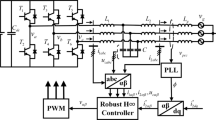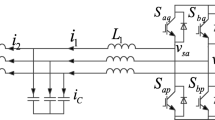Abstract
Aiming at the problem that the output voltage of relay inductive coupled power transfer (ICPT) system is susceptible to changes due to the influence of system load changes, frequency perturbations, and input voltage fluctuations, an H∞ mixed sensitivity robust control method is adopted to relay ICPT system to regulate the output voltage. First, the working principle of the relay ICPT system is analyzed. Then, the GSSA model of the relay ICPT system is established. By constructing the S/R/T mixed sensitivity function, a suitable weighting function is selected from the frequency domain perspective and converted into H∞ standard control problem to get a robust controller. Finally, an experimental platform is built to verify the control effect of the controller on the system output voltage. Experimental results show that the designed controller in this paper stabilizes the system output voltage and obtains good tracking performance, suppression parameter perturbation performance, anti-interference performance, and improves system robustness simultaneously.


















Similar content being viewed by others
Abbreviations
- G(s):
-
The nominal controlled object
- r :
-
The reference input signal
- u :
-
The control output signal
- e :
-
The system feedback error signal
- d :
-
The external interference signal
- y :
-
The system output signal
- z 1 :
-
The outputs of error output e through weighted functions WS
- z 2 :
-
The outputs of controller output u through weighted functions WR
- z 3 :
-
The outputs of system output y through weighted functions WT
- K(s):
-
The robust H∞ mixed sensitivity controller
- P(s):
-
The weighted augmented controlled object
- W S :
-
The output performance weighting function
- W R :
-
The control performance weighting function
- W T :
-
The robust performance weighting function
- S(s):
-
The transfer function of the closed-loop system from r to e when d is 0
- T(s):
-
The transfer function of the reference input r to the system output y
- R(s):
-
The closed-loop transfer function from the reference input r to the controlled output u
- I :
-
The identity matrix
- ∆:
-
The permissible perturbation
- \( \left\| {S\left( s \right)} \right\|_{\infty } \) :
-
Measure of the ability of the closed-loop system to suppress interference
- \( \left\| {T\left( s \right)} \right\|_{\infty } \) :
-
Measure of the magnitude of the permissible perturbation
- \( \left\| {R\left( s \right)} \right\|_{\infty } \) :
-
An additive perturbation. The measure of the magnitude of perturbation ∆ is allowed in G + ∆
- T zw :
-
The closed-loop transfer function matrix of the system from input r to output z
- σ:
-
Singular value
- G k :
-
The transfer function of the controller of the fourth-order
- μ :
-
The structural singular value
- D :
-
Duty cycle of switch S in buck circuit
References
Xia C, Li X, Sun Q et al (2020) Improving magnetic coupling characteristics of square coupler ICPT system by round corner design. Electr Eng. https://doi.org/10.1007/s00202-020-00932-9
Moon J, Hwang H, Jo B et al (2017) Design and implementation of a high-efficiency 6.78 MHz resonant wireless power transfer system with a 5 W fully integrated power receiver. IET Power Electron 10:577–587. https://doi.org/10.1049/iet-pel.2016.0107
Zhang W, Zhang T, Guo Q et al (2018) High-efficiency wireless power transfer system for 3D, unstationary free-positioning and multi-object charging. IET Electr Power Appl 12:658–665. https://doi.org/10.1049/iet-epa.2017.0581
Zhou S, Mi CC (2016) Multi-paralleled LCC reactive power compensation networks and their tuning method for electric vehicle dynamic wireless charging. IEEE Trans Industr Electron 63:6546–6556. https://doi.org/10.1109/TIE.2015.2512236
Onar OC, Chinthavali M, Campbell SL et al (2019) Vehicular integration of wireless power transfer systems and hardware interoperability case studies. IEEE Trans Ind Appl 55:5223–5234. https://doi.org/10.1109/TIA.2019.2928482
Campi T, Cruciani S, Palandrani F et al (2016) Wireless power transfer charging system for AIMDs and pacemakers. IEEE Trans Microw Theory Technol 64:633–642. https://doi.org/10.1109/TMTT.2015.2511011
Ahn D, Ghovanloo M (2016) Optimal design of wireless power transmission links for millimeter-sized biomedical implants. IEEE Trans Biomed Circuits Syst 10:125–137. https://doi.org/10.1109/TBCAS.2014.2370794
Wang W, Huang X, Guo J et al (2017) Power stabilization based on efficiency optimization for WPT systems with single relay by frequency configuration and distribution design of receivers. IEEE Trans Transp Electrif 32:7011–7024. https://doi.org/10.1109/TPEL.2016.2626498
Lee J, Lee K (2019) Effects of number of relays on achievable efficiency of magnetic resonant wireless power transfer. IEEE Trans Power Electron 35:6697–6700. https://doi.org/10.1109/TPEL.2019.2962504
Seo D (2017) Comparative analysis of two- and three-coil WPT systems based on transmission efficiency. IEEE ACCESS 7:2169–3536. https://doi.org/10.1109/ACCESS.2019.2947093
Jiang Y, Wang L, Wang Y et al (2018) Analysis, design, and implementation of WPT system for EV’s battery charging based on optimal operation frequency range. IEEE Trans Industr Electron 34:6890–6905. https://doi.org/10.1109/TPEL.2018.2873222
Yang Y, Zhong W, Kiratipongvoot S et al (2018) Dynamic improvement of series-series compensated wireless power transfer systems using discrete sliding mode control. IEEE Trans Power Electron 33:6351–6360. https://doi.org/10.1109/TPEL.2017.2747139
Xia C, Wang W, Ren S et al (2018) Robust control for inductively coupled power transfer systems with coil misalignment. IEEE Trans Power Electron 33:8110–8112. https://doi.org/10.1109/TPEL.2017.2771532
Hao H, Covic GA, Boys JT (2014) An approximate dynamic model of LCL-T-based inductive power transfer power supplies. IEEE Trans Power Electron 29:5554–5567. https://doi.org/10.1109/TPEL.2013.2293138
Banerjee A, Chaudhuri NR (2016) Robust damping of inter-area oscillations in AC-MTDC grids using H∞ mixed-sensitivity approach. 2016 IEEE Power Energy Society General Meeting (PESGM). https://doi.org/10.1109/PESGM.2016.7742013
Vall OM (2018) Mixed sensitivity H∞ control for LTI systems with varying time delays. J Syst Eng Electron 29:611–617. https://doi.org/10.21629/JSEE.2018.03.18
Saripudin, M. O. Asali, T. Indriyanto, et al (2019) Visual servoing using mixed sensitivity H∞ control for Yaw-Pitch camera platform. In: 2019 international conference of artificial intelligence and information technology (ICAIIT), IEEE, pp 48–53. http://doi.org/10.1109/ICAIIT.2019.8834610
Zames G (1981) Feedback and optimal sensitivity: model reference transformations, multiplicative seminorms, and approximate inverses. IEEE Trans Autom Control 26:318–328. https://doi.org/10.1109/TAC.1981.1102603
Doyle JC, Francis AB, Allen TR (1981) Feedback Control Theory. Macmilan, New York. https://doi.org/10.1007/978-0-387-85460-1_1
Cheng C, Zhou Z, Li W et al (2020) A power relay system with multiple loads using asymmetrical coil design. IEEE Trans Ind Electron. https://doi.org/10.1109/TCST.2016.2634502
Cheng C, Lu F, Zhou Z et al (2020) A load-independent LCC-compensated wireless power transfer system for multiple loads with a compact coupler design. IEEE Trans Ind Electron 67:4507–4515. https://doi.org/10.1109/TIE.2019.2931260
Hu AP (2009) Modeling a contactless power supply using GSSA method. In: Proc IEEE Int Conf Ind Technol, Feb. 2009, pp. 1–6. http://doi.org/10.1109/ICIT.2009.4939571
Skogestad S, Postlethwaite I (2001) Multivariable Feedback Control: Analysis and Design, 2nd edn. Wiley, New York
Gu DW, Petkov P, Konstantinov MM (2013) Robust Control Design With MATLAB. Springer, Berlin
Acknowledgements
This article is funded by the State Grid Corporation of China Science and Technology Project “Research on Wireless Charging Technology of Underwater Cable Inspection Robot Based on New Magnetic Conducting Device.”
Author information
Authors and Affiliations
Corresponding author
Additional information
Publisher's Note
Springer Nature remains neutral with regard to jurisdictional claims in published maps and institutional affiliations.
Rights and permissions
About this article
Cite this article
Wu, X., Xu, C., Wei, B. et al. H∞ mixed sensitivity robust control method of relay ICPT system for output voltage regulation. Electr Eng 103, 781–792 (2021). https://doi.org/10.1007/s00202-020-01116-1
Received:
Accepted:
Published:
Issue Date:
DOI: https://doi.org/10.1007/s00202-020-01116-1




